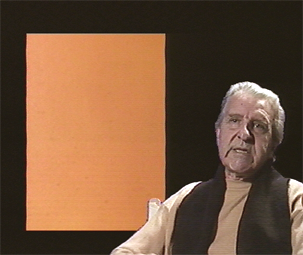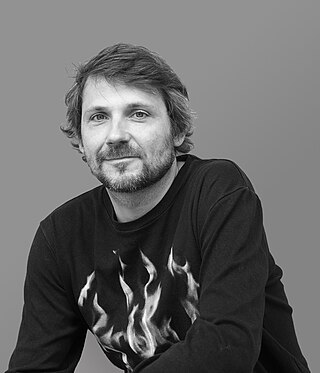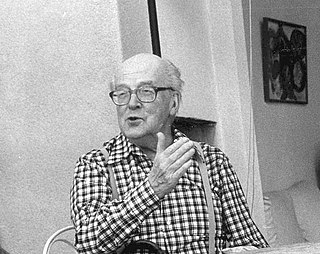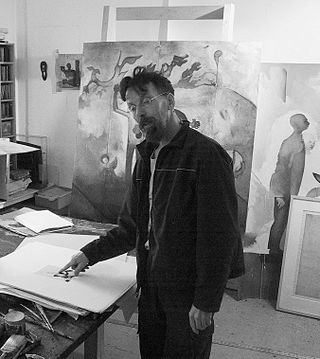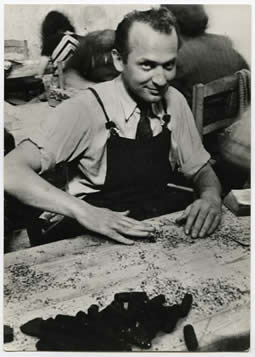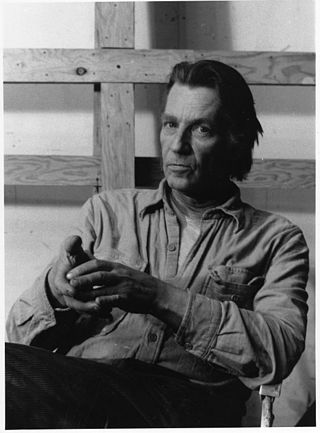Life and art
Jean Degottex was born in Sathonay-Camp and spent his childhood in Lyon. Coming from a modest background, he was almost self-taught. At the age of fifteen, he moved to Paris with his parents, quit school and began to earn his living. In Paris, he made contact with the libertarian circles of the 1930s, and occasionally practiced drawing in the academies of Montparnasse. He served in the military in Tunisia and Algeria from 1939 to 1941, years during which he painted his first figurative paintings, under the influence of Fauvism. [1]
He then decided to devote himself entirely to painting. From 1941, he took part in the "Salon for those under thirty" (Salon des moins de trente ans). From 1948 his art became abstract and was closer to lyrical abstraction. In 1949, he had his first exhibition, at the Denise René Gallery, which was associated with avant-garde abstract artists, and at the Beaune Gallery. That year he met Renée Beslon, poet, visual artist and art critic, who would remain his companion until his death.
in 1951 Degottex was awarded the Prix Kandinsky. From 1954, his style moved towards a gestural abstraction, favoring the freedom and speed of execution. [1]
In 1953, he exhibited at the L'Étoile scellée gallery, whose artistic director was André Breton. Breton saw in Degottex's latest works (Feu noir 12–1955, Ascendant 12–1955) a possible pictorial illustration of the principle of "automatic writing", which characterized the works of the surrealist artists. Degottex pointed out to him his spontaneous affinity with Chinese and Japanese writings, and especially with the philosophy and practices of Zen. [3]
The period from 1956 to 1963 was particularly fruitful in Degottex's career. It is also the best known to the public. During those years, he painted large-scale works, often in series with the same idea used repeatedly: suite Ashkenazi (1957), suite Serto (March–April, November 1957), suite des Hagakure (November 1957), les 18 Vides (1959), suite des Roses (1960), suite des Alliances (1960), les 7 Metasignes (1961), and Jshet (1962).
During this time he experienced tragedy when his daughter, Frédérique, died in an accident at the age of 16. After a year of mourning, Degottex resumed his series: Écritures, with the following works: the suites Rose-Noire (August 1964), Suite Obscure (November–December 1964), Metasphère (1966), ETC (December 1964 / March 1967) and Horsphères (1967). From 1966 until his death, he produced a wider collection of work in Gordes, in the Vaucluse region, where from the early 1970s, he lived in summers with Beslon.
From 1972 to 1976, he held several solo exhibitions at the Galerie Germain. In particular, he exhibited the Médias series. The works in the series usually contain two areas of separated color: a plain surface in matte black acrylic and a lower part in Chinese ink wash. [4]
He worked more and more with paper material: the tearing technique, for example, revealing this texture (seriés d’ARR rouges, puis blancs). The Germain Gallery also exhibited his Papiers Pleins (1974-1975), papers glued and peeled in horizontal stripes, and his Papiers pleins Obliques (1976) with incisions raised by diagonals. [1] With the work Papiers-Report (1977), he began to explore a new technique that involved "reporter" by folding half of the paper surface onto the other. He used this imprint technique on all sorts of materials, including large acrylic canvases, like in the séries des Lignes-Report (1978) and the Plis-Report (1978). In 1979 he created specifically for a solo exhibition at the Abbaye de Sénaque at Gordes, a series of paintings referred to as Déplis. [1]
In 1981 he was awarded the Grand National Prize of Painting (Grand Prix National de la Peinture). In 1982, he joined the Gallery of France and created the series of the Grilles-Collors, the Oblicollors, and the Diacollors. His last major works were the Lignes-Bois (1985) and the Contre-Lignes Bois (1986), in white, grey, or blue grey.
Jean Degottex died in Paris on 9 December 1988. [1]

